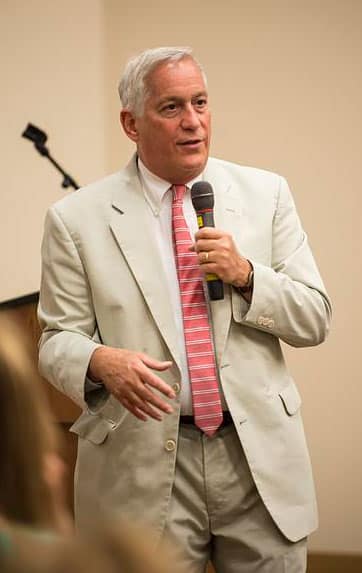
Read 'The Bill Of Obligations: The Ten Habits Of Good Citizens'
CMC’s 2024 Common Reader engages students, staff, and community members with a series of events in spring and fall, culminating in a series of visits by author Richard Haass.
CMC’s Common Reader program selects one book every year and offers it for free distribution across the dozens of communities CMC serves – followed by a series of discussions, author talks and conversations at CMC campuses.
2024’s Common Reader will kick off with a livestreamed interview between New York Times bestselling author Richard Haass and Walter Isaacson, former editor of TIME and chair of CNN and the namesake of CMC’s Isaacson School for Communication, Arts & Media.
Given that 2024 is an election year, CMC plans to collaborate with other organizations in the state including media partners and generous financial sponsors to bring even more people across Colorado’s Western Slope together around civics and civil discourse.
About The Bill of Obligations
The United States faces dangerous threats from Russia, China, North Korea, Iran, terrorists, climate change, and future pandemics. The greatest peril to the country, however, comes not from abroad but from within, from none other than ourselves. The question facing us is whether we are prepared to do what is necessary to save our democracy.
The Bill of Obligations is a bold call for change. In these pages, New York Times bestselling author Richard Haass argues that the very idea of citizenship must be revised and expanded. The Bill of Rights is at the center of our Constitution, yet our most intractable conflicts often emerge from contrasting views as to what our rights ought to be.


About Richard Haass
Richard is president emeritus of the Council on Foreign Relations after having served as CFR’s president for twenty years. A seasoned diplomat, he chaired the multiparty negotiations in 2013 in Northern Ireland that provided the foundation for the 2014 Stormont House Agreement. For his efforts to promote peace and conflict resolution, he received the 2013 Tipperary International Peace Award.
Books by Richard Haass include
- The Bill of Obligations (2023)
- The World: A Brief Introduction (2020)
- A World in Disarray (2017)
- Foreign Policy Begins at Home (2013)
- War of Necessity. War of Choice (2009)
- The Reluctant Sheriff: The United States After the Cold War (1997)

About Walter Isaacson
Walter Isaacson has held roles including editor of TIME magazine, CNN chairman and CEO, CEO of the Aspen Institute. He is currently a professor of history at Tulane University and a prolific author. His latest book “Elon Musk” (2023) quickly became yet another New York Times bestseller.
The Isaacson School for Communication, Arts & Media at Colorado Mountain College bears his name.
Books by Walter Isaacson include
- Elon Musk (2023)
- The Code Breaker (2021)
- Leonardo da Vinci (2017)
- The Innovators (2014)
- Steve Jobs (2011)
- Einstein: His Life and Universe (2007)
- Benjamin Franklin: An American Life (2003)
- Kissinger: A Biography (1992)
Book Copies
Check out or pick up a free hard copy of “The Bill of Obligations,” on a first come first serve basis at these locations.
eAudiobooks and eBooks are available from the Virtual Library through the Libby app.
CMC Aspen
Front Desk
CMC Breckenridge - Dillon
Campus Front Entrances
Summit County Libraries
CMC Carbondale
Front Desk
CMC Central Services
Executive Suite, 3rd Floor
Garfield County Libraries
CMC Leadville
New Discovery Reception
Lake County Public Library
CMC Glenwood Springs
Front Desk
Glenwood Springs Branch Library
CMC Rifle
Front Desk
Garfield County Public Libraries
CMC Salida
Front Desk
CMC Spring Valley
Ascent Center Front Desk
CMC Steamboat Springs
CMC Steamboat Springs Campus Library
CMC Vail Valley
Front Desk
Resources for Rediscovering Common Ground
- CMC Library Resources for Rediscovering Common Ground / Check out the eBook or eAudiobook of The Bill of Obligations here, and find further resources on civic engagement, including links to our country's founding documents and information on how to become a more involved member of our democracy.
- Watch A Citizen’s Guide to Preserving Democracy (video), Rocky Mountain PBS
- ‘Rediscovering Common Ground’ series launches with live virtual event, moderated by NPR's Mary Louise Kelly, Aspen Public Radio
We will continue to add to this list.
News coverage of Rediscovering Common Ground
- Aspen Public Radio
- Glenwood Springs Post Independent - CMC hosts free virtual event with bestselling authors to kick off ‘Rediscovering Common Ground’ series
- Steamboat Pilot - Rediscovering Common Ground, a nonpartisan series on the political divide, will launch Jan. 29 with live virtual event
- Colorado Times Recorder - ‘We Can’t Just Assume That It Will All Work Out in the End:’ Forum Explores How To Find Common Ground in a Divided Country
With Thanks to Collaborating Partners



